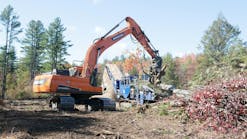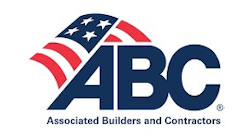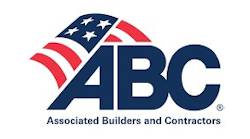Soil compaction is such a basic part of almost every construction project that it often gets overlooked and not given a second thought. But almost every manmade structure rests on a firm foundation of compacted soil. Compacting soil involves the increase of its in-place density to specified depth by means of mechanically applied force. A repeated impact to the soil by various weights and applied pressures reduces the soil’s void ratio and reduces its overall volume. Compaction is performed to avoid excessive settlement, minimize damage from frost heave, and minimize water seeps and structural instability. Soil compaction is a classic case of “out of sight, out of mind” with the compaction effort almost always hidden from view below grade or underneath a building’s foundation. It only becomes noticeable when it fails and its effects become apparent at the surface with cracking walls, tilting structures, and sinking buildings.
Why soil compaction is performed is obvious. This article examines how soil compaction is accomplished and what equipment performs the compaction.
Compaction Techniques
There are basically two ways to compact soil: the static application of heavy loads or the repeated dynamic application of smaller loads at high frequencies. Most compaction equipment utilizes both types of forces. These forces are in turn each divided into two separate techniques for applying these forces:
- Static
1. Pressure
2. Kneading
- Dynamic
1. Impact
2. Vibration
Static force is simply the operating weight of the compaction machine applied as a dead load to the soil underneath, relying on applied pressure and/or kneading of the soil to achieve compaction. Heavier machines have greater static loads. Compaction equipment operating on relatively steep slopes applies proportionally less direct dead weight depending on the angle of the slope to the horizontal. Static load is measured as pressure, the weight of the machine over the area of the parts of the machine that are in direct contact with the soil (pneumatic tires, steel drum, padded foot, etc.). The applied pressure, especially when delivered to many small areas, has the effect of kneading the soil. Static force is simple to apply but does not usually affect the soil to a significant depth. A static sheepsfoot and a static roller are examples of machines that primarily deliver pressure. Kneading of soil can be accomplished with scrapers and pneumatic tires.
Dynamic force is created not by dead weight but by a live engine that moves a mass in a reciprocating motion that delivers multiple impacts to the soil in a short period of time, relying on vibration and impact to get the job done. In keeping with the laws of physics, the resultant force is proportional the mass of the impact object times the square of its velocity. So while the weight of the impact mass doesn’t change, the force it translates to the soil can be greatly increased by increasing the speed of its impact. The repeated shock waves passing through the soil cause compaction to occur at greater depths than static force application. Rammers and dropped weights are examples of machines that use heavy impact for compaction. Vibratory sheepsfoot, vibratory roller, and vibratory plate are examples of dynamic compaction machines utilizing vibration.
So what method works best on which soils? As there are two main methods of compaction, there are two broad categories of soils: granular soils and cohesive soils. Granular soils consist of large particles from fine sands to large cobbles but are divided into two subcategories of sand and gravels. Cohesive soils consist of smaller particles of either clays or silts that are densely compacted and adhere together. Granular soils are best for foundation support, embankment shell construction, and roadway pavement subgrades. Cohesive soils are typically used to construct embankment cores as well as low-permeability liners for liquid containment in ponds, impoundments, and landfills.
Each type of compaction equipment is suitable for different kinds of soil:
- Sheepsfoot rollers using both dynamic vibration and static pressure applied over multiple small contact points are useful for compacting cohesive soils (100% to 50% clay).
- Pneumatic wheels using static kneading action are used for mixed cohesive and granular soils (75% sand/25% clay to 25% sand/75% clay).
- Rollers using both dynamic vibration and static pressure applied over a single large contact area can be used on granular soils (50% sand to 100% sand).
- High-speed rammers and tamping plates using dynamic impact are used on either cohesive or granular soils.
Measuring Compaction
So how much compaction is enough? That depends on the soil and its moisture content as well as the compaction application and the acceptance criteria. Soil can be compacted to provide a stable base for constructing a building foundation, a roadbed, a structural embankment, or an impoundment liner. Each application has a preferred level of compaction, soil type, and moisture content.
Detailed information on a soil’s physical state can be derived from a relatively simple series of laboratory tests. Two of the most common are the Standard and Modified Proctor tests. These tests determine the relationship between a soil’s density and moisture content and a set compaction effort. Each soil sample is subdivided into smaller test samples that are wetted to varying moisture contents. Each test sample is compacted into a standard mold measuring 57.6 cubic inches. In the Standard Proctor test, a hammer weight of 5.5 pounds is dropped on each of three lifts of soil from a height of 12 inches (resulting in compactive energy of 12,375 foot-pounds per cubic foot). The Modified Proctor increases this energy to 56,250 foot-pounds per cubic foot by dropping a 10-pound hammer from a height of 18 inches on each of five lifts of soil. The Proctor test was originally developed to control and measure the compaction of soils used as the foundation for highways and airfields. The standard test simulates the compaction of soil in the field with medium-sized compaction equipment, while the modified test approximates compaction with the heaviest compaction equipment.
The results of the compaction effort are measured by first determining the water content of each compacted sample and its dry unit weight. These values are plotted on a graph with the water content as the x-axis and the dry unit weight as the y-axis. Three sample points are usually used to create a compaction curve that resembles an upside-down parabola. The first sample is compacted at field water content. The second sample is compacted at a water content two percentage points wetter than the field sample. Depending on the outcome of the send test, a third sample is compacted at either two percentage points drier than the first sample or two percentage points wetter than the second sample. The top of the resultant parabola curve represents the soil’s optimum water content. That is, the specific moisture content that results in the highest dry unit weight.
Soil is typically compacted to either an acceptable moisture/density zone based on shear strength criteria (for embankment and foundation construction) or to an acceptable zone based on hydraulic conductivity (for lining ponds and landfills). To determine these zones, soil samples are compacted and the results plotted for three different curves resulting from modified, standard, and reduced compaction efforts. Along the upper right-hand side of these curves is plotted another curve representing the soil’s density and moisture characteristics at a zero air voids situation representing a completely saturated condition. This represents an ideal upper bound condition and is calculated from the previously determined compaction data. Acceptable zones are determined by the zero air voids curve, the lower bounds that represent the moisture and density relationships that result in the soil having the minimum required shear strength of the maximum allowable hydraulic conductivity.
Field tests can also be performed on in-situ compacted soils. They can all be done relatively fast with reasonable to high degrees of accuracy. Aside from applying a pocket penetrometer to the soil with hand pressure, a field measurement of soil usually involves the removal of a large sample with hand shovels. The resultant hole is then filled with material of known volume, such as sand, which is poured into the hole to measure its volume (also known as the sand cone test). Meanwhile, the excavated soil is weighed and compared with the volume of the hole it was extracted from to determine its in-place density. A more measured volume sample can be extracted with a Shelby tube. Direct measurement of a soil’s density can be made by using a nuclear gauge to measure the radiation from a gamma ray source driven into the soil to a fixed depth.Compaction Equipment
There are four broad categories of soil compaction equipment: handheld rammers and tamping plates, vibratory and static sheepsfoot, vibratory and static rollers, and pneumatic tire compactors.
Rammers and Tamping Plates
Often referred to as “jumping jacks,” handheld vibratory plate compactors and rammers are used for those situations that do not require production of large quantities of compacted soil for soil compaction efforts confined to small areas. Like their cousin the jackhammer, tampers and rammers use centrifugal force generated by machine vibration induced into a flat contact plate to compact soils. They come in two types, one way or reversible. With a one-way tamping plate, the operator can only move forward with his machine as it performs compaction. A reversible tamper allows the operator to move back and forth over the area he is compacting.
Small compacted soil quantities are usually required for small repair and maintenance work done to failed areas (or areas that were not compacted correctly in the first place) of a liner or embankment, the compaction of soil in confined areas (such as along the bottom of a trench), or small quantities of granular soils (such as sand, gravel, crushed aggregate, or mixed soils used as the base for small paved areas). When working in confined spaces, such as a trench bottom, where the operator cannot easily make a full turn back to his stopping point, reversible tampers and rammers are a necessity. Diesel rammers provide the power necessary for heavy-duty compaction in areas to small for heavy soil compaction equipment. Neither a vibratory plate nor a power rammer is suitable for use in wet clayey or otherwise cohesive soils, though vibratory tampers work well on soil with low to moderate fines content.
Multiquip Inc. manufactures a complete line of rammers and vibratory plate tampers. Its rammers can run either on diesel or a four-cycle gasoline engine. With contact shoes ranging from 5.9 inches to 1.2 inches, Multiquip’s MT series delivers ramming forces from 1,215 to 3,500 pounds at up to 700 blows per minute. In size they start at the lightweight and easily portable MTR40F to the MT84FA with its 3.5-horsepower engine. Even heavier are Multiquip’s rugged diesel models, the MT76D2 and the MT86D2, which can pound a 13-inch shoe with a force of 4,400 pounds. The company also offers a line of forward and reversible plate compactors powered by 2.4-horsepower to 6.0-horsepower engines designed for the efficient compaction of sand, gravel, and cohesive soils. The reversible plate compactors also come equipped with two eccentric weights, which increase the compaction force while allowing for a smooth transition from forward to reverse.
In addition to its lines of planers, pavers, and vibratory rollers, Dynapac produces vibratory plates and rammers. The company’s LF series of single direction plate compactors delivers (at the light end) 2,000 pounds of force at a frequency of 5,520 revolutions per minute (rpm) to 4,725 pounds at 5,100 rpm. Vibratory jumping jack plate tampers, the LT series, are suitable for small repair jobs and confined spaces. Rounding out Dynapac’s product line are its LG series of gas-powered reversible plate compactors designed for compacting either asphalt or granular soils. For bigger jobs, there is the LP series of diesel-powered, walk-behind vibratory drum rollers.
Amman America produces four-stroke diesel rammers and two-stroke gasoline rammers for small compaction jobs. A wide variety (80 different types) of vibrating compactors is also available from Amman, allowing for site-specific compaction applications. In addition to traditional forward and reversible plate compactors, Amman offers remote-controlled models. Complementing this product line is a specialized line of rollers for trench compaction, both the light AC series for trench compaction and the tandem roller AV series for base compaction.
Sheepsfoot and Padded Rollers
Sheepsfoot rollers, so the story goes, were born out of the observation that the soils adjacent to the gate of a sheep hold were dense and stiffly compacted as the result of thousands of little sheep hooves pounding the earth. With this observation came the realization that force concentrated into many small “footprints” could be more effective on some soils than the same weight applied to a broad flat area impacted by a smooth drum roller. Sheepsfoot rollers are also known as tamping rollers. They resemble a smooth drum roller with projecting club-shaped feet fixed to the drum’s surface in a regular pattern. The roller drums themselves are empty, and the additional weight is provided by water or sand fill. The operating mass of a sheepsfoot roller can vary between 5 and 8 tons. Though mostly used on cohesive soils, they can be used on sands and gravels with sufficient fines and moisture content. Sheepsfoot rollers are not used on very coarse soils and uniform gravels.
Certain distinctions should be made between sheepsfoot rollers and the similar padded foot rollers. The sheepsfoot contact points are peg shaped and more deeply penetrating than those of padded foot rollers. As such, sheepsfoot rollers are mostly used to tie together via compaction and secondary kneading separate layers of clay. Usually, the clay is placed in loose lifts as thick as the length of the sheepsfoot itself; an 8-inch loose lift is fairly common. Repeated passes by the sheepsfoot roller compacts the loose lift and binds it to the lower, previously compacted lift, resulting in a newly compacted layer of about 6 inches in thickness. Such an operation is typically performed to construct compacted clay liners for landfills and other impoundments. Sheepsfoot rollers come in both static and vibratory types (adding dynamic compaction along with the static pressure and kneading). They also come in pull-behind models (typically hitched to a large dozer) or self-propelled ride-on models with one or two rollers.
By contrast, padded foot compactors are of a shallower rectangular shape but can also be used to compact clays. However, a padded foot’s penetration is less than that of a sheepsfoot but is also used in earth compaction primarily for sub-base construction. When used for sub-base construction, padded foot rollers more resemble smooth drum rollers in application. While the sheepsfoot roller is ideal for achieving low permeability, padded foott rollers are suitable for achieving strength compaction. Both are different than the smooth drum compactor, which is used on dry materials such as granular soils used to construct road base.
Caterpillar’s newest addition to its extensive line of soil compaction equipment is the 825H soil compactor. With an operating weight of 72,164 pounds and powered by a 453-net-horsepower C15 ACERT engine, the 825H is designed to meet aggressive Tier 3 emission standards. While adding a new engine and cooling system, it retains those features that made the old 825G a success (high-efficiency hydraulics, ease of use, durable frame structure, etc.). Its engine is designed to reduce emissions while ensuring constant power by means of an electronically configured transmission system that provides constant horsepower throughout its operating range. This addition to its line of compaction equipment complements Caterpillar’s established padded foot and smooth drum CP series and CS series vibratory soil rollers. The CP series machines range in size from 10,190 pounds to 37,050 pounds and are designed to operate on uneven or steep terrain. The CS series machines are designed for site preparation and base compaction applications. Some of these models come with optional padded foot shell kit for differing applications.
Bomag provides static, padded foot compactors in the heavy weight class, the 35-ton BC772 and the 29-ton BC672. Able to handle large earth compaction jobs such as dam embankments, they are high-speed compactors driven by water-cooled diesel engines protected by complete underbody enclosure. The enclosed frames fully protect the hydrostatic drives, axles, and engine compartment, protecting them all from dirt penetration. One interesting feature is the special polygonal wheels with high-torsion-resistant padfeet shaped to maximize static compaction.
Smooth Rollers
For large-quantity production of compacted granular soils, smooth rollers are the machines of choice. Whether in single-drum or dual-drum configurations, smooth-drum rollers are suitable for compaction of granular soil base layers. This includes building foundations and roadway sub-bases, as well as the compaction of surface courses of asphalt paving. Like sheepsfoot drums, smooth-drum rollers are available in either tow-behind or self-propelled ride-on models. Their operating weights range from 2 to 20 tons, and (again, like other rollers) they are hollow with weight provided by sand or water fill. While useful for compacting granular soils such as well-graded sands and gravels, they are not used for the compaction of cohesive silts and clays with low plasticity and/or high moisture content and are not as effective on uniform sands or silty sands.
Similar to the smooth-drum roller is the not-so-smooth grid roller. Ranging in weight from 5 to 12 tons, grid rollers have surfaces of spaced heavy bar stock constructed in a cylinder or raised surface Z-patterns that resemble basket weaving. This raised drum surface impresses grooves into the soil while leaving raised knobs of earth in between. When used on wet clays, the soil tends to adhere to the lower portion of the surface pattern, filling it in and effectively transforming the grid drum into a smooth roller. More suitable soils include well-graded sands, soft rocks, and stones. In fact, one of the primary uses of grid is the breaking up or “rubble-ization” of existing concrete pavement surface and the pulverization of stone and rubble into finer particles.
In addition to its heavy weight padded foot static compactors, Bomag manufactures a line of tandem vibratory smooth rollers, the BW series running from the lightweight BW120AD-4 (5,732-pound operating weight) to the hefty BW284 (28,425 pounds). What makes these machines unique are the little things that make for a more efficient compaction effort: slanted drum supporting improving operator visibility of the drum edges, central lifting point for ease of loading and off-loading, easy access to daily maintenance check points, bolt-on heavy-duty articulation joints, and so on. All are designed for high-production soil compaction tasks.
The Case Corp. (aka CNH Global) manufactures a line of SV series machines that can be equipped with either a smooth or padfoot drum. Equipped with high-traction, hydrostatic drive that synchronizes the rear wheels with the compaction drum and a low center of gravity, Case’s SV compactors are suitable for work on steep grades. The drum’s vibration oscillation can be set to either low amplitude and high frequency for granular materials or high amplitude and low frequency for cohesive soils.
Sakai America offers a wide range of high-force vibratory soil compactors designed for rapid compaction of all types of soil, rockfill, recycled base materials, and soil cement at the lowest possible cost. Featuring high-centrifugal-force outputs; dual amplitude/dual frequency; choice of drum configurations; drum and axle drives for traction; heavy-duty, center hitch design; and three braking choices, Sakai has four compactors in its SV510 line ranging in weight from 24,140 to 29,875 pounds. Sakai also offers a full complement of high-frequency vibratory asphalt rollers for superior density and smoothness.
Reflecting its overall diversified product lines, Ingersoll-Rand produces a line of SD series large soil compactors with diverse applications. This product line includes the 16,350-pound SD-77 (smooth or two different padded foot drums); the SD-116, which operates well on steep grades due to its Ultra-Grade traction system and axles and drive motors designed for climbing; the high-powered SD-160 with its six-cylinder turbocharged engine, which can handle thicker lifts with fewer passes; and the 205-hp SD-200 for heavy-duty applications. Ingersoll-Rand also provides an auxiliary line of small soil compactors ranging from the 2.6-ton SD-2D TF to the SD-70 D/F. All the company’s models come with two-piece, clamp-on padfoot shell kits for conversion to cohesive soil compaction.
Pneumatic Tires
Pneumatic-tired rollers utilize heavy wheels aligned to produce a rolled track the width of the compaction vehicle. When not a tow-behind single-axle model, a pneumatic tire compactor usually is configured on a two-axle self-propelled ride-on vehicle. Dead loads for pneumatic tire compactors range from 12 to 40 tons. The tires provide soil compaction through a kneading action and are best suited for both coarse and fine grained soils, with the exception of very soft clays and variable soils. Pneumatic tire compactors are extensively used in roadway construction to compact base, sub-base, and wearing course materials.
In addition to sheepsfoot, padded foot, and smooth drum rollers, Caterpillar also manufactures a line of pneumatic tire compactors. From the 23,100-pound PF-300B to the high-productivity PS-360C (which can operate as heavy as 40,785 pounds when its drums are filled with wet sand), these pneumatic compactors are suitable for use on base, sub-base, or wear course materials by providing a kneading action and a high weight-per-wheel ratio.








